Hackney (Parliament Politics Magazine) – Hackney school streets suffer vandalism, raising safety fears among parents and teachers; authorities condemn ‘mindless’ attacks on road restrictions.
22 cases of illegal damage to school street infrastructure have been documented since last June, according to a Freedom of Information (FoI) request made to Hackney Council after homeowners complained “appalling criminal sabotage.”
In an effort to “make it easier and safer to walk and cycle to school,” the council has been experimenting with temporary restrictions on road use outside of schools during their opening and closing times since 2017.
This policy has been implemented for years by placing speed measurement strips, sometimes known as “traffic counters,” on the asphalt and mounting cameras on lampposts.
In the Springfield and Cazenove wards of the borough, the most of the damage is located around elementary schools.
The streets outside of Simon Marks, Springfield Community, Holmleigh, and Sir Thomas Abney schools are the most severely impacted.
The majority of the occurrences that have been reported point to foul play: vandals have leveled their support poles, moved cameras, destroyed their wiring, or spray-painted over signs or timings.
Craig, a parent, informed the Citizen that a camera post on Castlewood Road, the location of Springfield Community School, was fractured at ground level after being chopped by “what looked like an angle grinder.”
There doesn’t seem to be anyone there to monitor [the street] , prevent [attacks] or just physically shut it when it should be shut,”
he said, leaving the restricted zones effectively “lawless”.
It’s totally rammed. The cars are often like pulling out, blowing their horns at each other.
My kid, he’s seven and he scoots down to school, but I need to have him really close because the cars will mount the pavement and turn into corners.
Everyone parks in the double yellows – even with the chevrons there. It’s grim, to be honest, and pretty dangerous.”
Another resident, Alice, lambasted drivers acting like they had a “right to drive where they wish, at whatever cost”.
It is absurd that some believe speed and convenience to be more important than human life,” she said.
If Hackney cannot guarantee that school streets can be enforced and enjoyed, they should close the streets altogether.
I am certain that a child will soon be hit by a car if action is not taken.”
The FoI response described one instance in which a car struck a school street sign at Hackney New School on Enfield Road; however, it is not obvious from the report if this was intentional vandalism.
The borough has one of the biggest school streets programs in the UK, according to Town Hall, impacting over 20,000 students in 83% of primary and 26% of secondary schools.
However, in recent years, the Labour-led government has been under constant fire for implementing 49 school streets and 19 low-traffic neighborhoods (LTNs).
The council has had to replace or repair damaged infrastructure as a result of the frequent vandalism, which has put a heavy financial load on it. Resources that may be utilized for other community initiatives are diverted in this way.
While companies have complained that the measures disrupt important thoroughfares for customers, others contend that the measures have simply resulted in larger concentrations of air pollution in particular places.
Conservative councillor Simche Steinberger, who represents Springfield ward and ran for the mayoralty on an anti-LTN platform, told the Citizen he “never wants to see vandalism” but stressed that school streets were displacing rather than reducing traffic.
“Originally, nobody in that school ever wanted to have school streets – not the school, not us,”
he said.
I genuinely don’t believe they have done anything, anywhere. Maybe in the road where the school is there’s obviously less traffic, but in the surrounding roads, the traffic has increased by 10 times as much.”
Cllr. Sarah Young, the borough’s transport and climate director, called the attempt by vandals to thwart the council’s objectives “staggering.”
“School streets help to reduce congestion and improve air quality at the school gates, making it easier and safer for children to cycle, scoot, run, walk or wheel their way to school without worry,”
she said.
She added that the fact that some people have chosen to run a campaign of vandalism to undermine safer streets for children on their way to and from school is staggering.
They work closely with the police to identify and prosecute anyone who carries out these dangerous acts of vandalism.
According to a Town Hall representative, the Met has successfully prosecuted those found to have vandalized enforcement cameras and formally cautioned those involved.
Hackney Council has stated its intention to evaluate every primary and secondary school in the borough for a school street.
Cllr. Young declared today that the council would have a public consultation to get opinions from the local population on the borough’s transportation plan, which will include accessibility, air quality, and road safety measures.
What are the key highlights of the nature of this vandalism?
Destroying cameras that enforce traffic regulations and tearing down sign poles are examples of vandalism. In addition to being expensive, these actions jeopardize initiatives to make children’s surroundings safer.
Because these acts undermine the efficacy of School Streets efforts, parents are concerned about the safety consequences.
The goal of these initiatives is to lessen traffic jams and enhance the quality of the air near schools during rush hour.
These actions are seen by the community as sabotage that jeopardizes children’s safety and wellbeing. More steps are strongly needed to stop this kind of damage and guarantee that School Streets initiatives continue to be successful.
There is pressure on the mayor and local government to deal with this problem in a way that works. This may entail tightening the penalty for vandalism, enhancing the durability of signs, or stepping up surveillance.


